BUSN 1019 - Analysis of Partnership Scenarios under the 1891 Act
VerifiedAdded on 2023/06/07
|8
|2396
|255
Case Study
AI Summary
This case study provides a detailed analysis of various partnership scenarios under the Partnership Act 1891. It examines issues such as the existence of a partnership between Todd and Zac, Zac's entitlement to money from beer sales, liability for outstanding rent, compensation for damages, the legality of Zac's departure, and the classification of property as partnership assets. Each issue is addressed with relevant sections of the Partnership Act 1891 applied to the facts, leading to conclusions about the rights and liabilities of the partners. The analysis covers aspects like profit sharing, agent responsibilities, termination conditions, and property ownership within a partnership framework.
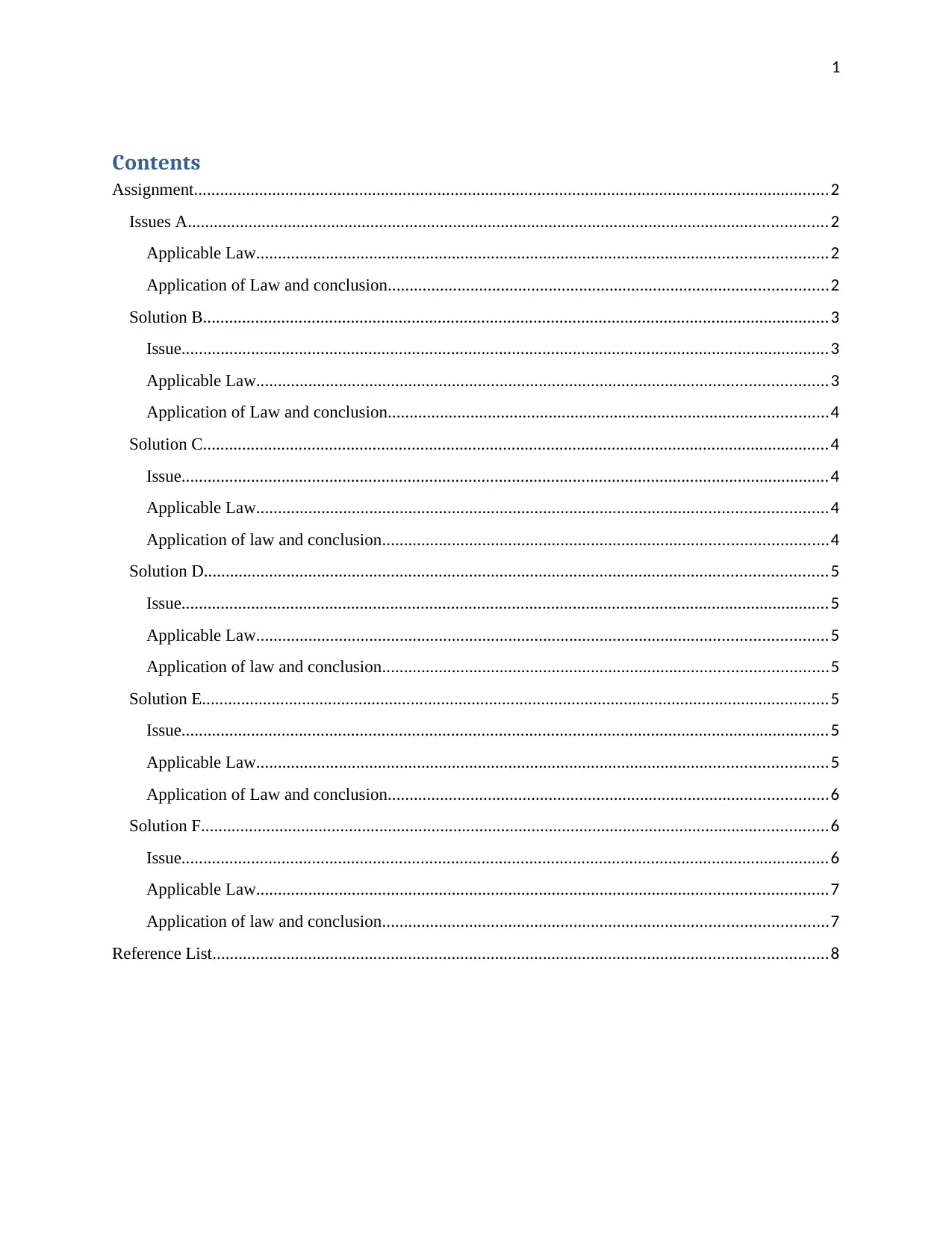
1
Contents
Assignment..................................................................................................................................................2
Issues A...................................................................................................................................................2
Applicable Law...................................................................................................................................2
Application of Law and conclusion.....................................................................................................2
Solution B................................................................................................................................................3
Issue.....................................................................................................................................................3
Applicable Law...................................................................................................................................3
Application of Law and conclusion.....................................................................................................4
Solution C................................................................................................................................................4
Issue.....................................................................................................................................................4
Applicable Law...................................................................................................................................4
Application of law and conclusion......................................................................................................4
Solution D...............................................................................................................................................5
Issue.....................................................................................................................................................5
Applicable Law...................................................................................................................................5
Application of law and conclusion......................................................................................................5
Solution E................................................................................................................................................5
Issue.....................................................................................................................................................5
Applicable Law...................................................................................................................................5
Application of Law and conclusion.....................................................................................................6
Solution F................................................................................................................................................6
Issue.....................................................................................................................................................6
Applicable Law...................................................................................................................................7
Application of law and conclusion......................................................................................................7
Reference List.............................................................................................................................................8
Contents
Assignment..................................................................................................................................................2
Issues A...................................................................................................................................................2
Applicable Law...................................................................................................................................2
Application of Law and conclusion.....................................................................................................2
Solution B................................................................................................................................................3
Issue.....................................................................................................................................................3
Applicable Law...................................................................................................................................3
Application of Law and conclusion.....................................................................................................4
Solution C................................................................................................................................................4
Issue.....................................................................................................................................................4
Applicable Law...................................................................................................................................4
Application of law and conclusion......................................................................................................4
Solution D...............................................................................................................................................5
Issue.....................................................................................................................................................5
Applicable Law...................................................................................................................................5
Application of law and conclusion......................................................................................................5
Solution E................................................................................................................................................5
Issue.....................................................................................................................................................5
Applicable Law...................................................................................................................................5
Application of Law and conclusion.....................................................................................................6
Solution F................................................................................................................................................6
Issue.....................................................................................................................................................6
Applicable Law...................................................................................................................................7
Application of law and conclusion......................................................................................................7
Reference List.............................................................................................................................................8
Paraphrase This Document
Need a fresh take? Get an instant paraphrase of this document with our AI Paraphraser
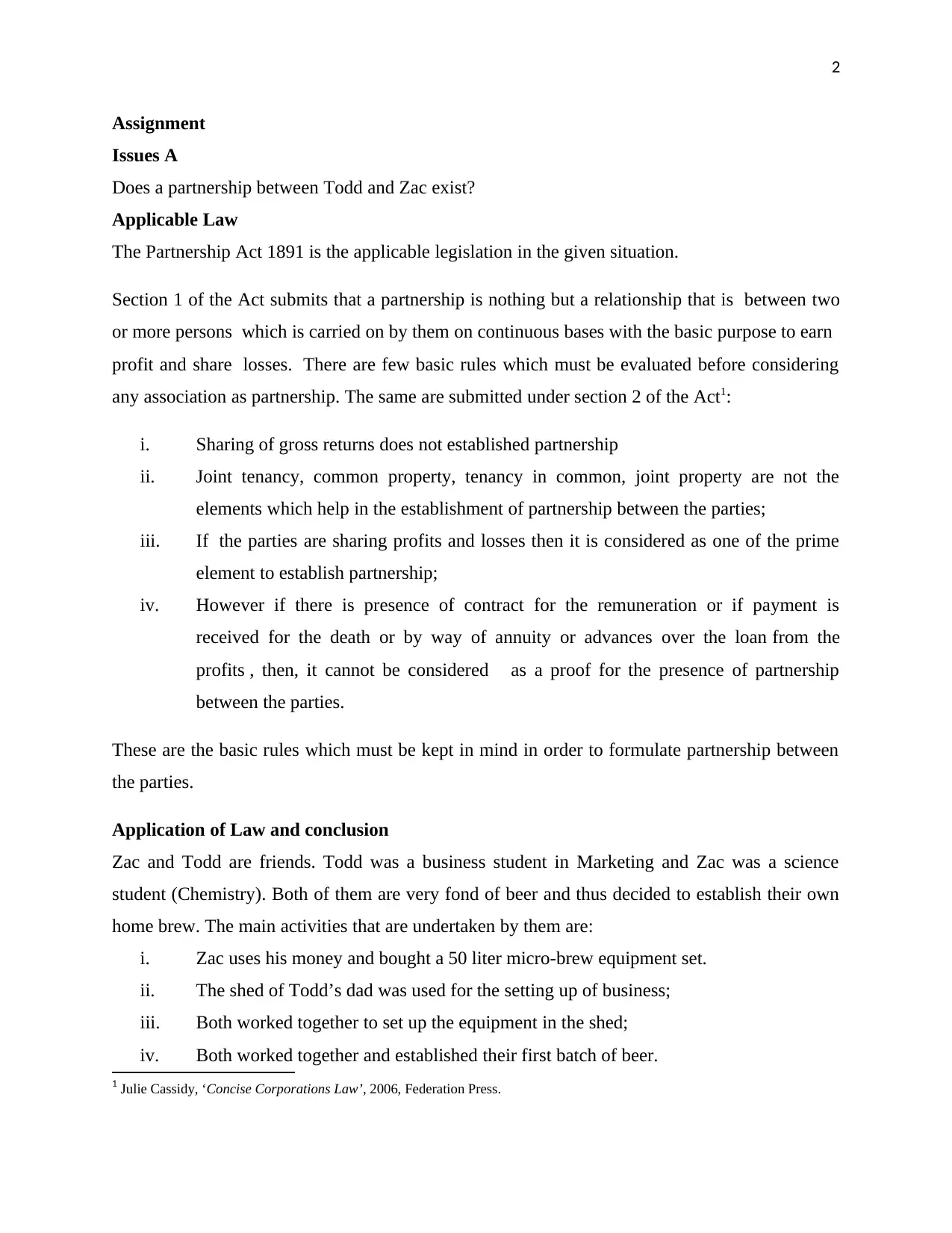
2
Assignment
Issues A
Does a partnership between Todd and Zac exist?
Applicable Law
The Partnership Act 1891 is the applicable legislation in the given situation.
Section 1 of the Act submits that a partnership is nothing but a relationship that is between two
or more persons which is carried on by them on continuous bases with the basic purpose to earn
profit and share losses. There are few basic rules which must be evaluated before considering
any association as partnership. The same are submitted under section 2 of the Act1:
i. Sharing of gross returns does not established partnership
ii. Joint tenancy, common property, tenancy in common, joint property are not the
elements which help in the establishment of partnership between the parties;
iii. If the parties are sharing profits and losses then it is considered as one of the prime
element to establish partnership;
iv. However if there is presence of contract for the remuneration or if payment is
received for the death or by way of annuity or advances over the loan from the
profits , then, it cannot be considered as a proof for the presence of partnership
between the parties.
These are the basic rules which must be kept in mind in order to formulate partnership between
the parties.
Application of Law and conclusion
Zac and Todd are friends. Todd was a business student in Marketing and Zac was a science
student (Chemistry). Both of them are very fond of beer and thus decided to establish their own
home brew. The main activities that are undertaken by them are:
i. Zac uses his money and bought a 50 liter micro-brew equipment set.
ii. The shed of Todd’s dad was used for the setting up of business;
iii. Both worked together to set up the equipment in the shed;
iv. Both worked together and established their first batch of beer.
1 Julie Cassidy, ‘Concise Corporations Law’, 2006, Federation Press.
Assignment
Issues A
Does a partnership between Todd and Zac exist?
Applicable Law
The Partnership Act 1891 is the applicable legislation in the given situation.
Section 1 of the Act submits that a partnership is nothing but a relationship that is between two
or more persons which is carried on by them on continuous bases with the basic purpose to earn
profit and share losses. There are few basic rules which must be evaluated before considering
any association as partnership. The same are submitted under section 2 of the Act1:
i. Sharing of gross returns does not established partnership
ii. Joint tenancy, common property, tenancy in common, joint property are not the
elements which help in the establishment of partnership between the parties;
iii. If the parties are sharing profits and losses then it is considered as one of the prime
element to establish partnership;
iv. However if there is presence of contract for the remuneration or if payment is
received for the death or by way of annuity or advances over the loan from the
profits , then, it cannot be considered as a proof for the presence of partnership
between the parties.
These are the basic rules which must be kept in mind in order to formulate partnership between
the parties.
Application of Law and conclusion
Zac and Todd are friends. Todd was a business student in Marketing and Zac was a science
student (Chemistry). Both of them are very fond of beer and thus decided to establish their own
home brew. The main activities that are undertaken by them are:
i. Zac uses his money and bought a 50 liter micro-brew equipment set.
ii. The shed of Todd’s dad was used for the setting up of business;
iii. Both worked together to set up the equipment in the shed;
iv. Both worked together and established their first batch of beer.
1 Julie Cassidy, ‘Concise Corporations Law’, 2006, Federation Press.
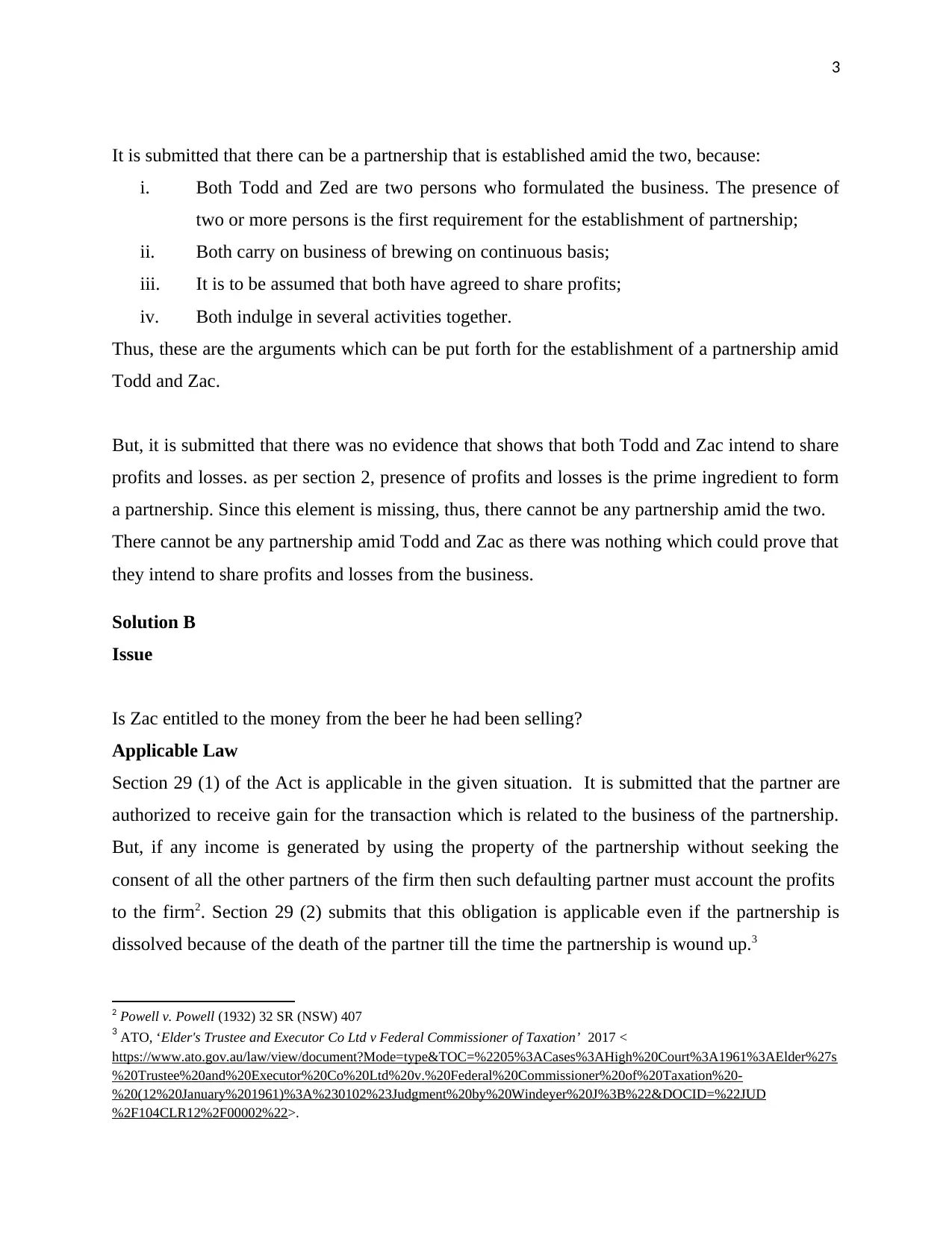
3
It is submitted that there can be a partnership that is established amid the two, because:
i. Both Todd and Zed are two persons who formulated the business. The presence of
two or more persons is the first requirement for the establishment of partnership;
ii. Both carry on business of brewing on continuous basis;
iii. It is to be assumed that both have agreed to share profits;
iv. Both indulge in several activities together.
Thus, these are the arguments which can be put forth for the establishment of a partnership amid
Todd and Zac.
But, it is submitted that there was no evidence that shows that both Todd and Zac intend to share
profits and losses. as per section 2, presence of profits and losses is the prime ingredient to form
a partnership. Since this element is missing, thus, there cannot be any partnership amid the two.
There cannot be any partnership amid Todd and Zac as there was nothing which could prove that
they intend to share profits and losses from the business.
Solution B
Issue
Is Zac entitled to the money from the beer he had been selling?
Applicable Law
Section 29 (1) of the Act is applicable in the given situation. It is submitted that the partner are
authorized to receive gain for the transaction which is related to the business of the partnership.
But, if any income is generated by using the property of the partnership without seeking the
consent of all the other partners of the firm then such defaulting partner must account the profits
to the firm2. Section 29 (2) submits that this obligation is applicable even if the partnership is
dissolved because of the death of the partner till the time the partnership is wound up.3
2 Powell v. Powell (1932) 32 SR (NSW) 407
3 ATO, ‘Elder's Trustee and Executor Co Ltd v Federal Commissioner of Taxation’ 2017 <
https://www.ato.gov.au/law/view/document?Mode=type&TOC=%2205%3ACases%3AHigh%20Court%3A1961%3AElder%27s
%20Trustee%20and%20Executor%20Co%20Ltd%20v.%20Federal%20Commissioner%20of%20Taxation%20-
%20(12%20January%201961)%3A%230102%23Judgment%20by%20Windeyer%20J%3B%22&DOCID=%22JUD
%2F104CLR12%2F00002%22>.
It is submitted that there can be a partnership that is established amid the two, because:
i. Both Todd and Zed are two persons who formulated the business. The presence of
two or more persons is the first requirement for the establishment of partnership;
ii. Both carry on business of brewing on continuous basis;
iii. It is to be assumed that both have agreed to share profits;
iv. Both indulge in several activities together.
Thus, these are the arguments which can be put forth for the establishment of a partnership amid
Todd and Zac.
But, it is submitted that there was no evidence that shows that both Todd and Zac intend to share
profits and losses. as per section 2, presence of profits and losses is the prime ingredient to form
a partnership. Since this element is missing, thus, there cannot be any partnership amid the two.
There cannot be any partnership amid Todd and Zac as there was nothing which could prove that
they intend to share profits and losses from the business.
Solution B
Issue
Is Zac entitled to the money from the beer he had been selling?
Applicable Law
Section 29 (1) of the Act is applicable in the given situation. It is submitted that the partner are
authorized to receive gain for the transaction which is related to the business of the partnership.
But, if any income is generated by using the property of the partnership without seeking the
consent of all the other partners of the firm then such defaulting partner must account the profits
to the firm2. Section 29 (2) submits that this obligation is applicable even if the partnership is
dissolved because of the death of the partner till the time the partnership is wound up.3
2 Powell v. Powell (1932) 32 SR (NSW) 407
3 ATO, ‘Elder's Trustee and Executor Co Ltd v Federal Commissioner of Taxation’ 2017 <
https://www.ato.gov.au/law/view/document?Mode=type&TOC=%2205%3ACases%3AHigh%20Court%3A1961%3AElder%27s
%20Trustee%20and%20Executor%20Co%20Ltd%20v.%20Federal%20Commissioner%20of%20Taxation%20-
%20(12%20January%201961)%3A%230102%23Judgment%20by%20Windeyer%20J%3B%22&DOCID=%22JUD
%2F104CLR12%2F00002%22>.
⊘ This is a preview!⊘
Do you want full access?
Subscribe today to unlock all pages.

Trusted by 1+ million students worldwide
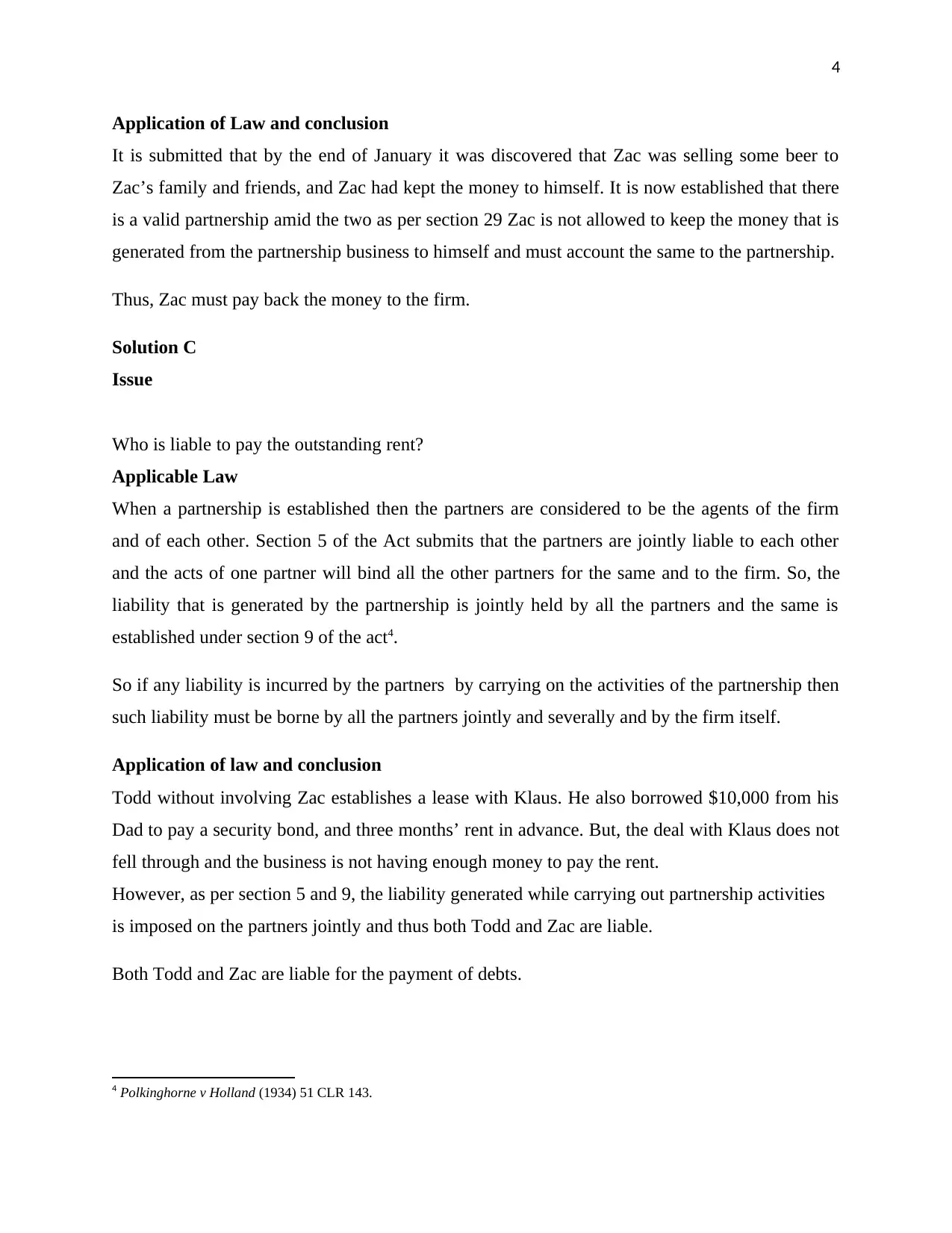
4
Application of Law and conclusion
It is submitted that by the end of January it was discovered that Zac was selling some beer to
Zac’s family and friends, and Zac had kept the money to himself. It is now established that there
is a valid partnership amid the two as per section 29 Zac is not allowed to keep the money that is
generated from the partnership business to himself and must account the same to the partnership.
Thus, Zac must pay back the money to the firm.
Solution C
Issue
Who is liable to pay the outstanding rent?
Applicable Law
When a partnership is established then the partners are considered to be the agents of the firm
and of each other. Section 5 of the Act submits that the partners are jointly liable to each other
and the acts of one partner will bind all the other partners for the same and to the firm. So, the
liability that is generated by the partnership is jointly held by all the partners and the same is
established under section 9 of the act4.
So if any liability is incurred by the partners by carrying on the activities of the partnership then
such liability must be borne by all the partners jointly and severally and by the firm itself.
Application of law and conclusion
Todd without involving Zac establishes a lease with Klaus. He also borrowed $10,000 from his
Dad to pay a security bond, and three months’ rent in advance. But, the deal with Klaus does not
fell through and the business is not having enough money to pay the rent.
However, as per section 5 and 9, the liability generated while carrying out partnership activities
is imposed on the partners jointly and thus both Todd and Zac are liable.
Both Todd and Zac are liable for the payment of debts.
4 Polkinghorne v Holland (1934) 51 CLR 143.
Application of Law and conclusion
It is submitted that by the end of January it was discovered that Zac was selling some beer to
Zac’s family and friends, and Zac had kept the money to himself. It is now established that there
is a valid partnership amid the two as per section 29 Zac is not allowed to keep the money that is
generated from the partnership business to himself and must account the same to the partnership.
Thus, Zac must pay back the money to the firm.
Solution C
Issue
Who is liable to pay the outstanding rent?
Applicable Law
When a partnership is established then the partners are considered to be the agents of the firm
and of each other. Section 5 of the Act submits that the partners are jointly liable to each other
and the acts of one partner will bind all the other partners for the same and to the firm. So, the
liability that is generated by the partnership is jointly held by all the partners and the same is
established under section 9 of the act4.
So if any liability is incurred by the partners by carrying on the activities of the partnership then
such liability must be borne by all the partners jointly and severally and by the firm itself.
Application of law and conclusion
Todd without involving Zac establishes a lease with Klaus. He also borrowed $10,000 from his
Dad to pay a security bond, and three months’ rent in advance. But, the deal with Klaus does not
fell through and the business is not having enough money to pay the rent.
However, as per section 5 and 9, the liability generated while carrying out partnership activities
is imposed on the partners jointly and thus both Todd and Zac are liable.
Both Todd and Zac are liable for the payment of debts.
4 Polkinghorne v Holland (1934) 51 CLR 143.
Paraphrase This Document
Need a fresh take? Get an instant paraphrase of this document with our AI Paraphraser
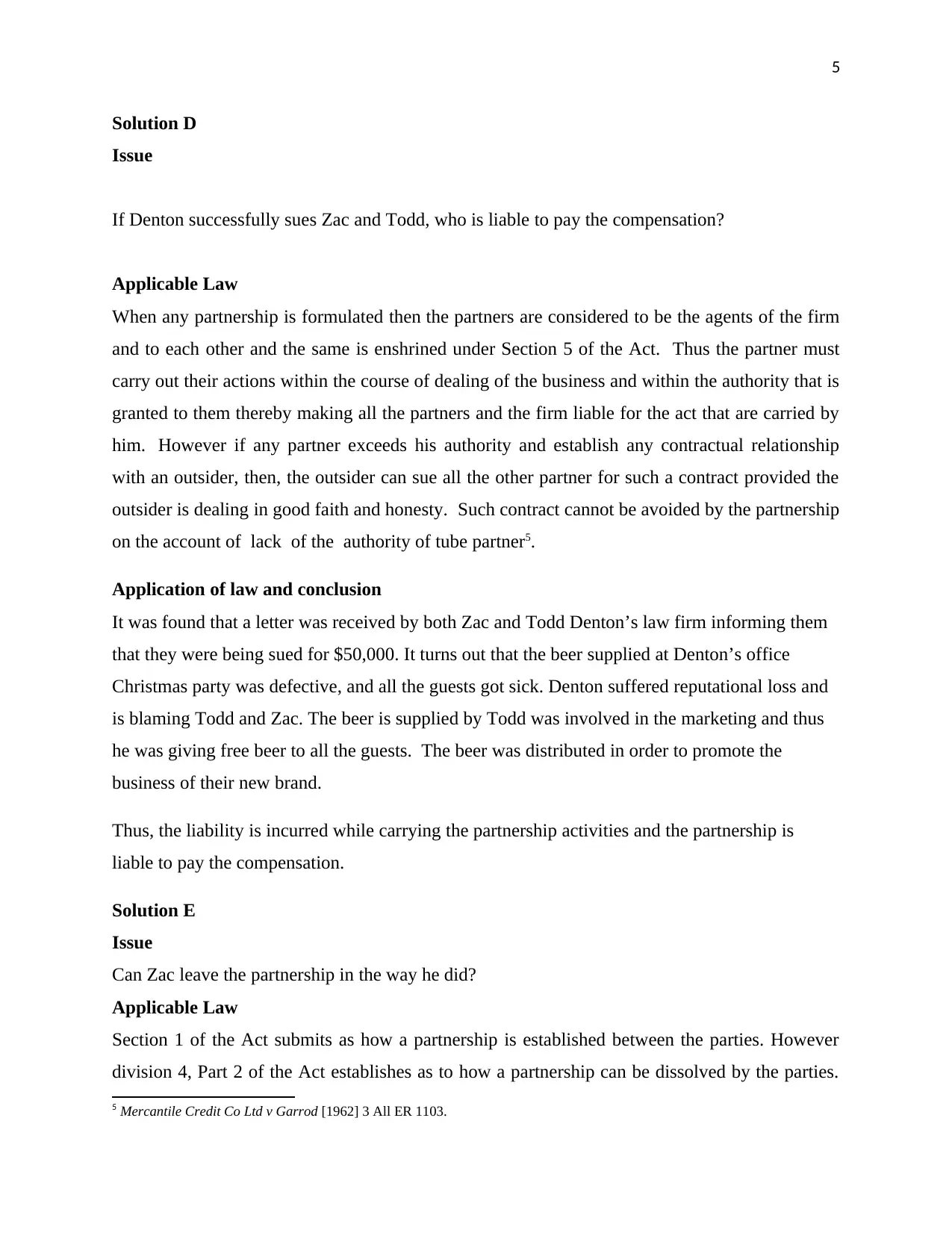
5
Solution D
Issue
If Denton successfully sues Zac and Todd, who is liable to pay the compensation?
Applicable Law
When any partnership is formulated then the partners are considered to be the agents of the firm
and to each other and the same is enshrined under Section 5 of the Act. Thus the partner must
carry out their actions within the course of dealing of the business and within the authority that is
granted to them thereby making all the partners and the firm liable for the act that are carried by
him. However if any partner exceeds his authority and establish any contractual relationship
with an outsider, then, the outsider can sue all the other partner for such a contract provided the
outsider is dealing in good faith and honesty. Such contract cannot be avoided by the partnership
on the account of lack of the authority of tube partner5.
Application of law and conclusion
It was found that a letter was received by both Zac and Todd Denton’s law firm informing them
that they were being sued for $50,000. It turns out that the beer supplied at Denton’s office
Christmas party was defective, and all the guests got sick. Denton suffered reputational loss and
is blaming Todd and Zac. The beer is supplied by Todd was involved in the marketing and thus
he was giving free beer to all the guests. The beer was distributed in order to promote the
business of their new brand.
Thus, the liability is incurred while carrying the partnership activities and the partnership is
liable to pay the compensation.
Solution E
Issue
Can Zac leave the partnership in the way he did?
Applicable Law
Section 1 of the Act submits as how a partnership is established between the parties. However
division 4, Part 2 of the Act establishes as to how a partnership can be dissolved by the parties.
5 Mercantile Credit Co Ltd v Garrod [1962] 3 All ER 1103.
Solution D
Issue
If Denton successfully sues Zac and Todd, who is liable to pay the compensation?
Applicable Law
When any partnership is formulated then the partners are considered to be the agents of the firm
and to each other and the same is enshrined under Section 5 of the Act. Thus the partner must
carry out their actions within the course of dealing of the business and within the authority that is
granted to them thereby making all the partners and the firm liable for the act that are carried by
him. However if any partner exceeds his authority and establish any contractual relationship
with an outsider, then, the outsider can sue all the other partner for such a contract provided the
outsider is dealing in good faith and honesty. Such contract cannot be avoided by the partnership
on the account of lack of the authority of tube partner5.
Application of law and conclusion
It was found that a letter was received by both Zac and Todd Denton’s law firm informing them
that they were being sued for $50,000. It turns out that the beer supplied at Denton’s office
Christmas party was defective, and all the guests got sick. Denton suffered reputational loss and
is blaming Todd and Zac. The beer is supplied by Todd was involved in the marketing and thus
he was giving free beer to all the guests. The beer was distributed in order to promote the
business of their new brand.
Thus, the liability is incurred while carrying the partnership activities and the partnership is
liable to pay the compensation.
Solution E
Issue
Can Zac leave the partnership in the way he did?
Applicable Law
Section 1 of the Act submits as how a partnership is established between the parties. However
division 4, Part 2 of the Act establishes as to how a partnership can be dissolved by the parties.
5 Mercantile Credit Co Ltd v Garrod [1962] 3 All ER 1103.
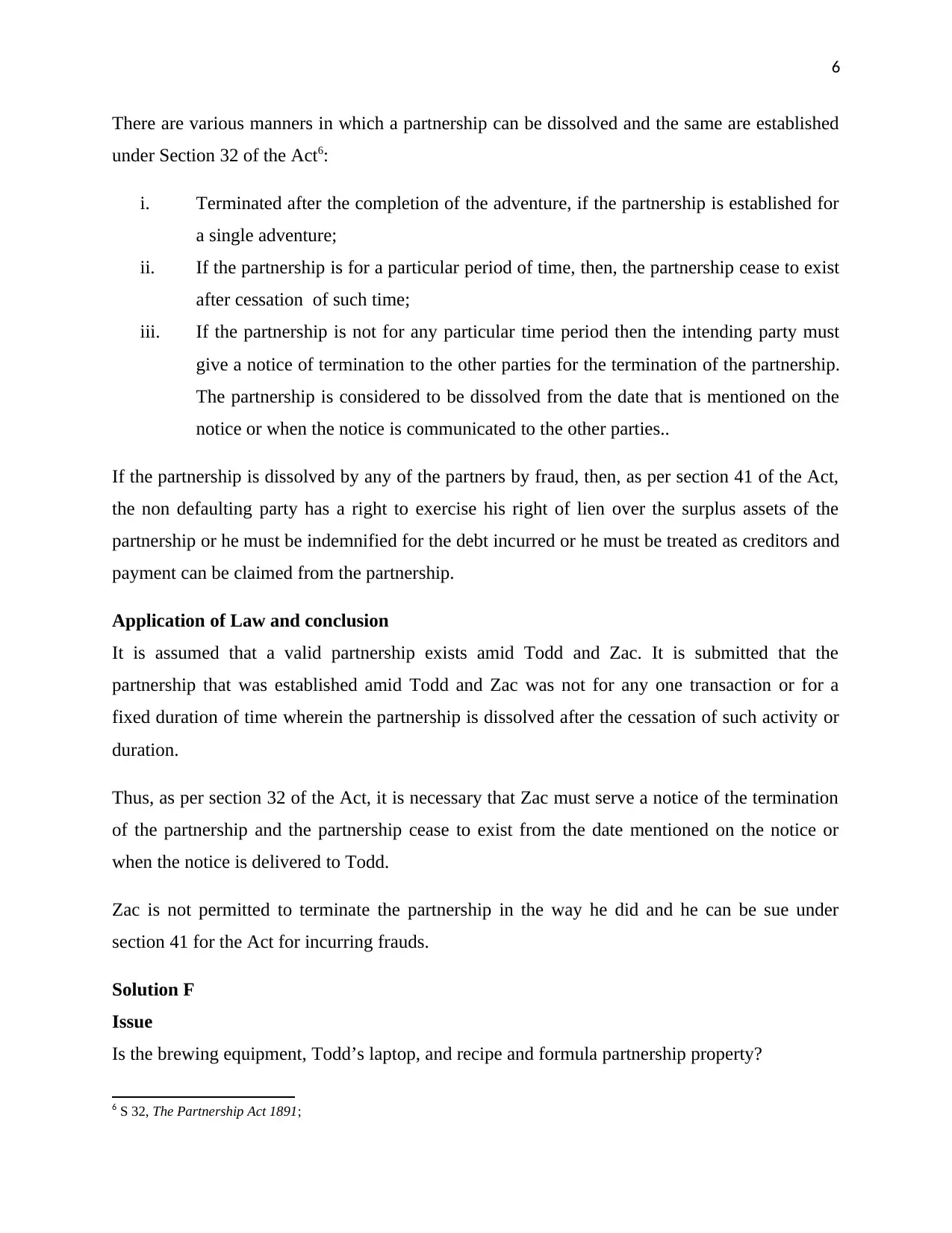
6
There are various manners in which a partnership can be dissolved and the same are established
under Section 32 of the Act6:
i. Terminated after the completion of the adventure, if the partnership is established for
a single adventure;
ii. If the partnership is for a particular period of time, then, the partnership cease to exist
after cessation of such time;
iii. If the partnership is not for any particular time period then the intending party must
give a notice of termination to the other parties for the termination of the partnership.
The partnership is considered to be dissolved from the date that is mentioned on the
notice or when the notice is communicated to the other parties..
If the partnership is dissolved by any of the partners by fraud, then, as per section 41 of the Act,
the non defaulting party has a right to exercise his right of lien over the surplus assets of the
partnership or he must be indemnified for the debt incurred or he must be treated as creditors and
payment can be claimed from the partnership.
Application of Law and conclusion
It is assumed that a valid partnership exists amid Todd and Zac. It is submitted that the
partnership that was established amid Todd and Zac was not for any one transaction or for a
fixed duration of time wherein the partnership is dissolved after the cessation of such activity or
duration.
Thus, as per section 32 of the Act, it is necessary that Zac must serve a notice of the termination
of the partnership and the partnership cease to exist from the date mentioned on the notice or
when the notice is delivered to Todd.
Zac is not permitted to terminate the partnership in the way he did and he can be sue under
section 41 for the Act for incurring frauds.
Solution F
Issue
Is the brewing equipment, Todd’s laptop, and recipe and formula partnership property?
6 S 32, The Partnership Act 1891;
There are various manners in which a partnership can be dissolved and the same are established
under Section 32 of the Act6:
i. Terminated after the completion of the adventure, if the partnership is established for
a single adventure;
ii. If the partnership is for a particular period of time, then, the partnership cease to exist
after cessation of such time;
iii. If the partnership is not for any particular time period then the intending party must
give a notice of termination to the other parties for the termination of the partnership.
The partnership is considered to be dissolved from the date that is mentioned on the
notice or when the notice is communicated to the other parties..
If the partnership is dissolved by any of the partners by fraud, then, as per section 41 of the Act,
the non defaulting party has a right to exercise his right of lien over the surplus assets of the
partnership or he must be indemnified for the debt incurred or he must be treated as creditors and
payment can be claimed from the partnership.
Application of Law and conclusion
It is assumed that a valid partnership exists amid Todd and Zac. It is submitted that the
partnership that was established amid Todd and Zac was not for any one transaction or for a
fixed duration of time wherein the partnership is dissolved after the cessation of such activity or
duration.
Thus, as per section 32 of the Act, it is necessary that Zac must serve a notice of the termination
of the partnership and the partnership cease to exist from the date mentioned on the notice or
when the notice is delivered to Todd.
Zac is not permitted to terminate the partnership in the way he did and he can be sue under
section 41 for the Act for incurring frauds.
Solution F
Issue
Is the brewing equipment, Todd’s laptop, and recipe and formula partnership property?
6 S 32, The Partnership Act 1891;
⊘ This is a preview!⊘
Do you want full access?
Subscribe today to unlock all pages.

Trusted by 1+ million students worldwide
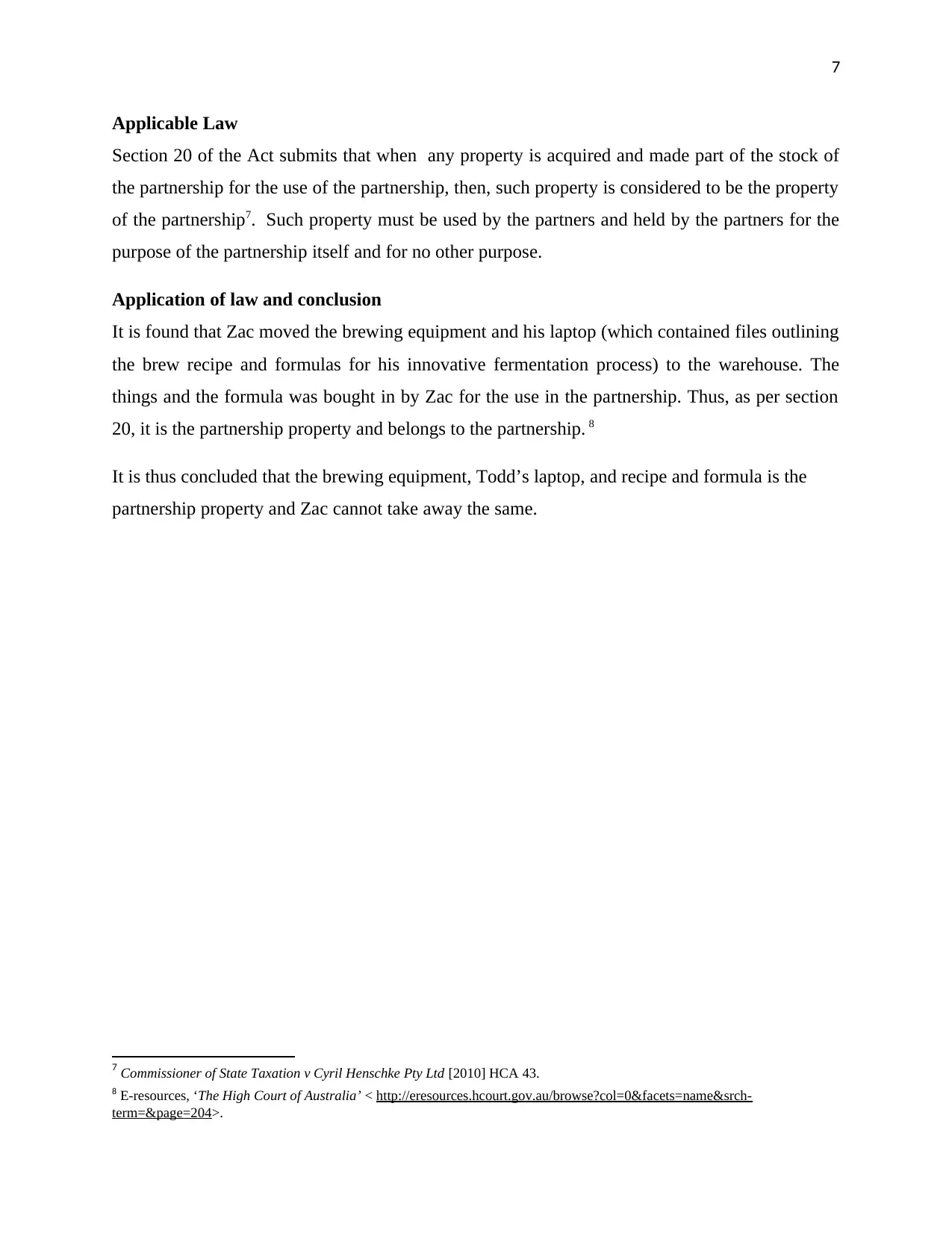
7
Applicable Law
Section 20 of the Act submits that when any property is acquired and made part of the stock of
the partnership for the use of the partnership, then, such property is considered to be the property
of the partnership7. Such property must be used by the partners and held by the partners for the
purpose of the partnership itself and for no other purpose.
Application of law and conclusion
It is found that Zac moved the brewing equipment and his laptop (which contained files outlining
the brew recipe and formulas for his innovative fermentation process) to the warehouse. The
things and the formula was bought in by Zac for the use in the partnership. Thus, as per section
20, it is the partnership property and belongs to the partnership. 8
It is thus concluded that the brewing equipment, Todd’s laptop, and recipe and formula is the
partnership property and Zac cannot take away the same.
7 Commissioner of State Taxation v Cyril Henschke Pty Ltd [2010] HCA 43.
8 E-resources, ‘The High Court of Australia’ < http://eresources.hcourt.gov.au/browse?col=0&facets=name&srch-
term=&page=204>.
Applicable Law
Section 20 of the Act submits that when any property is acquired and made part of the stock of
the partnership for the use of the partnership, then, such property is considered to be the property
of the partnership7. Such property must be used by the partners and held by the partners for the
purpose of the partnership itself and for no other purpose.
Application of law and conclusion
It is found that Zac moved the brewing equipment and his laptop (which contained files outlining
the brew recipe and formulas for his innovative fermentation process) to the warehouse. The
things and the formula was bought in by Zac for the use in the partnership. Thus, as per section
20, it is the partnership property and belongs to the partnership. 8
It is thus concluded that the brewing equipment, Todd’s laptop, and recipe and formula is the
partnership property and Zac cannot take away the same.
7 Commissioner of State Taxation v Cyril Henschke Pty Ltd [2010] HCA 43.
8 E-resources, ‘The High Court of Australia’ < http://eresources.hcourt.gov.au/browse?col=0&facets=name&srch-
term=&page=204>.
Paraphrase This Document
Need a fresh take? Get an instant paraphrase of this document with our AI Paraphraser

8
Reference List
Books/Articles/Journals
Cassidy, J, ‘Concise Corporations Law’, 2006, Federation Press.
Case Laws
Commissioner of State Taxation v Cyril Henschke Pty Ltd [2010] HCA 43.
Mercantile Credit Co Ltd v Garrod [1962] 3 All ER 1103.
Powell v. Powell (1932) 32 SR (NSW) 407;
Polkinghorne v Holland (1934) 51 CLR 143.
Legislation
The Partnership Act 1891;
Online Material
ATO, ‘Elder's Trustee and Executor Co Ltd v Federal Commissioner of Taxation’ 2017 <
https://www.ato.gov.au/law/view/document?Mode=type&TOC=%2205%3ACases%3AHigh
%20Court%3A1961%3AElder%27s%20Trustee%20and%20Executor%20Co%20Ltd%20v.
%20Federal%20Commissioner%20of%20Taxation%20-%20(12%20January%201961)%3A
%230102%23Judgment%20by%20Windeyer%20J%3B%22&DOCID=%22JUD
%2F104CLR12%2F00002%22>.
E-resources, ‘The High Court of Australia’ < http://eresources.hcourt.gov.au/browse?
col=0&facets=name&srch-term=&page=204>.
Reference List
Books/Articles/Journals
Cassidy, J, ‘Concise Corporations Law’, 2006, Federation Press.
Case Laws
Commissioner of State Taxation v Cyril Henschke Pty Ltd [2010] HCA 43.
Mercantile Credit Co Ltd v Garrod [1962] 3 All ER 1103.
Powell v. Powell (1932) 32 SR (NSW) 407;
Polkinghorne v Holland (1934) 51 CLR 143.
Legislation
The Partnership Act 1891;
Online Material
ATO, ‘Elder's Trustee and Executor Co Ltd v Federal Commissioner of Taxation’ 2017 <
https://www.ato.gov.au/law/view/document?Mode=type&TOC=%2205%3ACases%3AHigh
%20Court%3A1961%3AElder%27s%20Trustee%20and%20Executor%20Co%20Ltd%20v.
%20Federal%20Commissioner%20of%20Taxation%20-%20(12%20January%201961)%3A
%230102%23Judgment%20by%20Windeyer%20J%3B%22&DOCID=%22JUD
%2F104CLR12%2F00002%22>.
E-resources, ‘The High Court of Australia’ < http://eresources.hcourt.gov.au/browse?
col=0&facets=name&srch-term=&page=204>.
1 out of 8
Related Documents
Your All-in-One AI-Powered Toolkit for Academic Success.
+13062052269
info@desklib.com
Available 24*7 on WhatsApp / Email
![[object Object]](/_next/static/media/star-bottom.7253800d.svg)
Unlock your academic potential
Copyright © 2020–2025 A2Z Services. All Rights Reserved. Developed and managed by ZUCOL.


